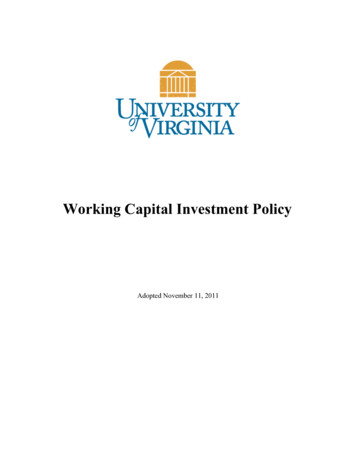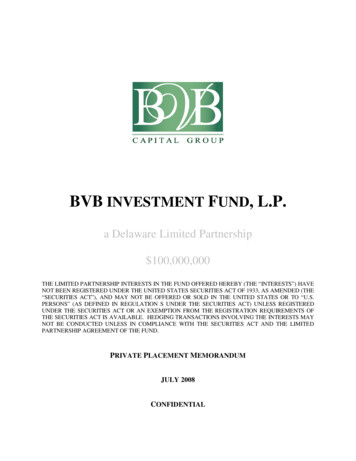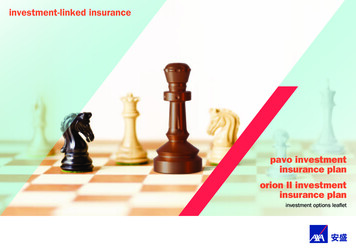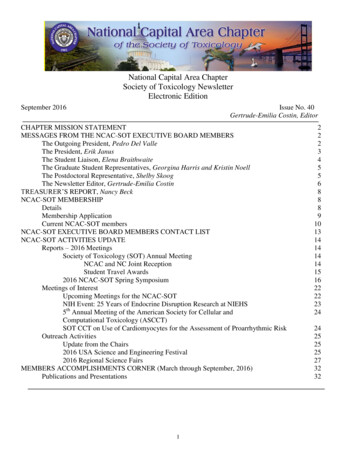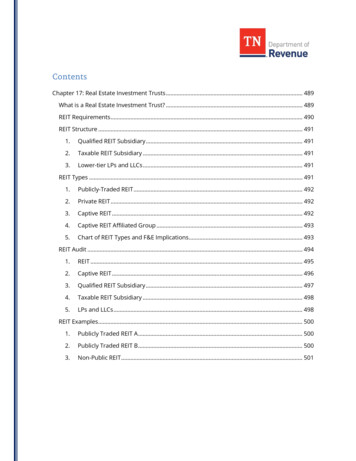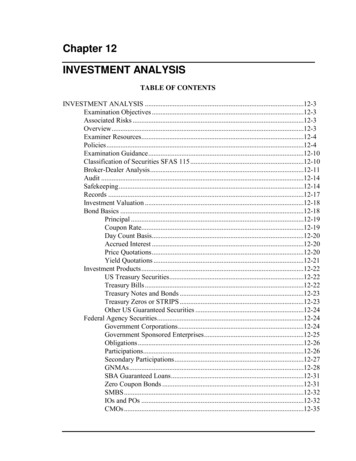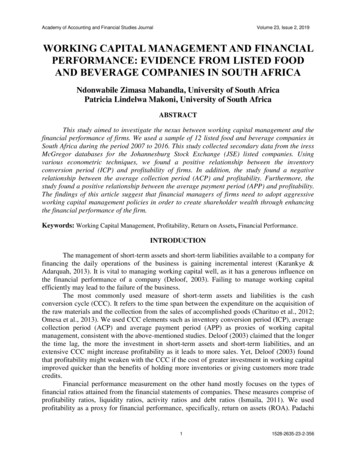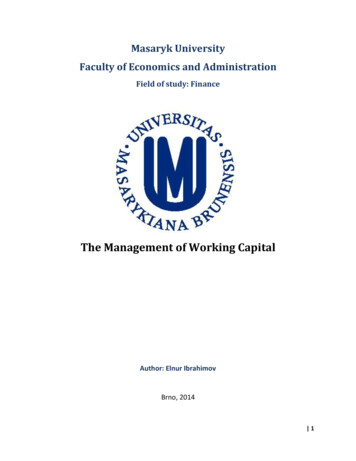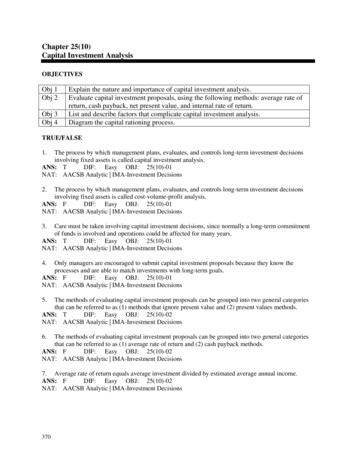
Transcription
Chapter 25(10)Capital Investment AnalysisOBJECTIVESObj 1Obj 2Obj 3Obj 4Explain the nature and importance of capital investment analysis.Evaluate capital investment proposals, using the following methods: average rate ofreturn, cash payback, net present value, and internal rate of return.List and describe factors that complicate capital investment analysis.Diagram the capital rationing process.TRUE/FALSE1.The process by which management plans, evaluates, and controls long-term investment decisionsinvolving fixed assets is called capital investment analysis.ANS: TDIF: Easy OBJ: 25(10)-01NAT: AACSB Analytic IMA-Investment Decisions2.The process by which management plans, evaluates, and controls long-term investment decisionsinvolving fixed assets is called cost-volume-profit analysis.ANS: FDIF: Easy OBJ: 25(10)-01NAT: AACSB Analytic IMA-Investment Decisions3.Care must be taken involving capital investment decisions, since normally a long-term commitmentof funds is involved and operations could be affected for many years.ANS: TDIF: Easy OBJ: 25(10)-01NAT: AACSB Analytic IMA-Investment Decisions4.Only managers are encouraged to submit capital investment proposals because they know theprocesses and are able to match investments with long-term goals.ANS: FDIF: Easy OBJ: 25(10)-01NAT: AACSB Analytic IMA-Investment Decisions5.The methods of evaluating capital investment proposals can be grouped into two general categoriesthat can be referred to as (1) methods that ignore present value and (2) present values methods.ANS: TDIF: Easy OBJ: 25(10)-02NAT: AACSB Analytic IMA-Investment Decisions6.The methods of evaluating capital investment proposals can be grouped into two general categoriesthat can be referred to as (1) average rate of return and (2) cash payback methods.ANS: FDIF: Easy OBJ: 25(10)-02NAT: AACSB Analytic IMA-Investment Decisions7. Average rate of return equals average investment divided by estimated average annual income.ANS: FDIF: Easy OBJ: 25(10)-02NAT: AACSB Analytic IMA-Investment Decisions370
Chapter 25(10) /Capital Investment Analysis 3718. Average rate of return equals estimated average annual income divided by average investment.ANS: TDIF: Easy OBJ: 25(10)-02NAT: AACSB Analytic IMA-Investment Decisions9.The method of analyzing capital investment proposals in which the estimated average annual incomeis divided by the average investment is the average rate of return method.ANS: TDIF: Easy OBJ: 25(10)-02NAT: AACSB Analytic IMA-Investment Decisions10. The excess of the cash flowing in from revenues over the cash flowing out for expenses is termed netcash flow.ANS: TDIF: Easy OBJ: 25(10)-02NAT: AACSB Analytic IMA-Investment Decisions11. The excess of the cash flowing in from revenues over the cash flowing out for expenses is termed netdiscounted cash flow.ANS: FDIF: Easy OBJ: 25(10)-02NAT: AACSB Analytic IMA-Investment Decisions12. The computations involved in the net present value method of analyzing capital investment proposalsare less involved than those for the average rate of return method.ANS: FDIF: Easy OBJ: 25(10)-02NAT: AACSB Analytic IMA-Investment Decisions13. The computations involved in the net present value method of analyzing capital investment proposalsare more involved than those for the average rate of return method.ANS: TDIF: Easy OBJ: 25(10)-02NAT: AACSB Analytic IMA-Investment Decisions14. Methods that ignore present value in capital investment analysis include the cash payback method.ANS: TDIF: Easy OBJ: 25(10)-02NAT: AACSB Analytic IMA-Investment Decisions15. Methods that ignore present value in capital investment analysis include the average rate of returnmethod.ANS: TDIF: Easy OBJ: 25(10)-02NAT: AACSB Analytic IMA-Investment Decisions16. Methods that ignore present value in capital investment analysis include the internal rate of returnmethod.ANS: FDIF: Easy OBJ: 25(10)-02NAT: AACSB Analytic IMA-Investment Decisions17. Methods that ignore present value in capital investment analysis include the net present valuemethod.ANS: FDIF: Easy OBJ: 25(10)-02NAT: AACSB Analytic IMA-Investment Decisions
372 Chapter 25(10) /Capital Investment Analysis18. The average rate of return method of capital investment analysis gives consideration to the presentvalue of future cash flows.ANS: FDIF: Easy OBJ: 25(10)-02NAT: AACSB Analytic IMA-Investment Decisions19. The cash payback method of capital investment analysis is one of the methods referred to as apresent value method.ANS: FDIF: Easy OBJ: 25(10)-02NAT: AACSB Analytic IMA-Investment Decisions20. The anticipated purchase of a fixed asset for 400,000, with a useful life of 5 years and no residualvalue, is expected to yield total net income of 300,000 for the 5 years. The expected average rate ofreturn is 30%.ANS: TDIF: ModerateOBJ: 25(10)-02NAT: AACSB Analytic IMA-Investment Decisions21. The anticipated purchase of a fixed asset for 400,000, with a useful life of 5 years and no residualvalue, is expected to yield total net income of 300,000 for the 5 years. The expected average rate ofreturn is 37.5%.ANS: FDIF: ModerateOBJ: 25(10)-02NAT: AACSB Analytic IMA-Investment Decisions22. The anticipated purchase of a fixed asset for 400,000, with a useful life of 5 years and no residualvalue, is expected to yield total net income of 200,000 for the 5 years. The expected average rate ofreturn on investment is 50%.ANS: FDIF: ModerateOBJ: 25(10)-02NAT: AACSB Analytic IMA-Investment Decisions23. The anticipated purchase of a fixed asset for 400,000, with a useful life of 5 years and no residualvalue, is expected to yield total net income of 200,000 for the 5 years. The expected average rate ofreturn on investment is 25.0%.ANS: FDIF: ModerateOBJ: 25(10)-02NAT: AACSB Analytic IMA-Investment Decisions24. In net present value analysis for a proposed capital investment, the expected future net cash flows areaveraged and then reduced to their present values.ANS: FDIF: Easy OBJ: 25(10)-02NAT: AACSB Analytic IMA-Investment Decisions25. The expected period of time that will elapse between the date of a capital investment and thecomplete recovery in cash of the amount invested is called the discount period.ANS: FDIF: Easy OBJ: 25(10)-02NAT: AACSB Analytic IMA-Investment Decisions26. The expected period of time that will elapse between the date of a capital investment and thecomplete recovery in cash of the amount invested is called the cash payback period.ANS: TDIF: Easy OBJ: 25(10)-02NAT: AACSB Analytic IMA-Investment Decisions
Chapter 25(10) /Capital Investment Analysis 37327. If a proposed expenditure of 80,000 for a fixed asset with a 4-year life has an annual expected netcash flow and net income of 32,000 and 12,000, respectively, the cash payback period is 2.5 years.ANS: TDIF: ModerateOBJ: 25(10)-02NAT: AACSB Analytic IMA-Investment Decisions28. If a proposed expenditure of 80,000 for a fixed asset with a 4-year life has an annual expected netcash flow and net income of 32,000 and 12,000, respectively, the cash payback period is 4 years.ANS: FDIF: ModerateOBJ: 25(10)-02NAT: AACSB Analytic IMA-Investment Decisions29. For years one through five, a proposed expenditure of 250,000 for a fixed asset with a 5-year lifehas expected net income of 40,000, 35,000, 25,000, 25,000, and 25,000, respectively, and netcash flows of 90,000, 85,000, 75,000, 75,000, and 75,000, respectively. The cash paybackperiod is 3 years.ANS: TDIF: ModerateOBJ: 25(10)-02NAT: AACSB Analytic IMA-Investment Decisions30. For years one through five, a proposed expenditure of 500,000 for a fixed asset with a 5-year lifehas expected net income of 40,000, 35,000, 25,000, 25,000, and 25,000, respectively, and netcash flows of 90,000, 85,000, 75,000, 75,000, and 75,000, respectively. The cash paybackperiod is 5 years.ANS: FDIF: ModerateOBJ: 25(10)-02NAT: AACSB Analytic IMA-Investment Decisions31. In net present value analysis for a proposed capital investment, the expected future net cash flows arereduced to their present values.ANS: TDIF: Easy OBJ: 25(10)-02NAT: AACSB Analytic IMA-Investment Decisions32. If in evaluating a proposal by use of the net present value method there is a deficiency of the presentvalue of future cash inflows over the amount to be invested, the proposal should be rejected.ANS: TDIF: Easy OBJ: 25(10)-02NAT: AACSB Analytic IMA-Investment Decisions33. If in evaluating a proposal by use of the net present value method there is a deficiency of the presentvalue of future cash inflows over the amount to be invested, the proposal should be accepted.ANS: FDIF: Easy OBJ: 25(10)-02NAT: AACSB Analytic IMA-Investment Decisions34. If in evaluating a proposal by use of the net present value method there is an excess of the presentvalue of future cash inflows over the amount to be invested, the rate of return on the proposalexceeds the rate used in the analysis.ANS: TDIF: ModerateOBJ: 25(10)-02NAT: AACSB Analytic IMA-Investment Decisions35. If in evaluating a proposal by use of the net present value method there is an excess of the presentvalue of future cash inflows over the amount to be invested, the rate of return on the proposal is lessthan the rate used in the analysis.ANS: FDIF: ModerateOBJ: 25(10)-02NAT: AACSB Analytic IMA-Investment Decisions
374 Chapter 25(10) /Capital Investment Analysis36. A present value index can be used to rank competing capital investment proposals when the netpresent value method is used.ANS: TDIF: Easy OBJ: 25(10)-02NAT: AACSB Analytic IMA-Investment Decisions37. The internal rate of return method of analyzing capital investment proposals uses the present valueconcept to compute an internal rate of return expected from the proposals.ANS: TDIF: Easy OBJ: 25(10)-02NAT: AACSB Analytic IMA-Investment Decisions38. A series of equal cash flows at fixed intervals is termed an annuity.ANS: TDIF: Easy OBJ: 25(10)-02NAT: AACSB Analytic IMA-Investment Decisions39. A qualitative characteristic that may impact upon capital investment analysis is the impact ofinvestment proposals on product quality.ANS: TDIF: Easy OBJ: 25(10)-03NAT: AACSB Analytic IMA-Investment Decisions40. A qualitative characteristic that may impact upon capital investment analysis is manufacturingflexibility.ANS: TDIF: Easy OBJ: 25(10)-03NAT: AACSB Analytic IMA-Investment Decisions41. A qualitative characteristic that may impact upon capital investment analysis is employee morale.ANS: TDIF: Easy OBJ: 25(10)-03NAT: AACSB Analytic IMA-Investment Decisions42. A qualitative characteristic that may impact upon capital investment analysis is manufacturingproductivity.ANS: TDIF: Easy OBJ: 25(10)-03NAT: AACSB Analytic IMA-Investment Decisions43. A qualitative characteristic that may impact upon capital investment analysis is manufacturingcontrol.ANS: TDIF: Easy OBJ: 25(10)-03NAT: AACSB Analytic IMA-Investment Decisions44. Charitable contributions are often used as a means of reducing the amount of income tax expensearising from capital investment projects.ANS: FDIF: Easy OBJ: 25(10)-04NAT: AACSB Analytic IMA-Investment Decisions45. The process by which management allocates available investment funds among competing capitalinvestment proposals is termed present value analysis.ANS: FDIF: Easy OBJ: 25(10)-04NAT: AACSB Analytic IMA-Investment Decisions
Chapter 25(10) /Capital Investment Analysis 37546. The process by which management allocates available investment funds among competing capitalinvestment proposals is termed capital rationing.ANS: TDIF: Easy OBJ: 25(10)-04NAT: AACSB Analytic IMA-Investment Decisions47. A capital expenditures budget summarizes the decisions made for the acquisition of fixed assets forseveral future years.ANS: TDIF: Easy OBJ: 25(10)-04NAT: AACSB Analytic IMA-Investment Decisions48. Capital rationing is the process by which management decides how to divide the capital budgetamong the various departments or divisions in the company.ANS: FDIF: Easy OBJ: 25(10)-04NAT: AACSB Analytic IMA-Investment DecisionsMULTIPLE CHOICE1.The process by which management plans, evaluates, and controls long-term investment decisionsinvolving fixed assets is called:a. absorption cost analysisb. variable cost analysisc. capital investment analysisd. cost-volume-profit analysisANS: CDIF: Easy OBJ: 25(10)-01NAT: AACSB Analytic IMA-Investment Decisions2.Decisions to install new equipment, replace old equipment, and purchase or construct a new buildingare examples ofa. sales mix analysis.b. variable cost analysis.c. capital investment analysis.d. variable cost analysis.ANS: CDIF: Easy OBJ: 25(10)-01NAT: AACSB Analytic IMA-Investment Decisions3.Which of the following is important when evaluating long-term investments?a. Investments must earn a reasonable rate of returnb. Employees are able to determine and propose capital equipment for their divisions or departmentsc. Proposals should match long term goals.d. All of the above.ANS: DDIF: Easy OBJ: 25(10)-01NAT: AACSB Analytic IMA-Investment Decisions4.Which of the following are present value methods of analyzing capital investment proposals?a. Internal rate of return and average rate of returnb. Average rate of return and net present valuec. Net present value and internal rate of returnd. Net present value and paybackANS: CDIF: Easy OBJ: 25(10)-02NAT: AACSB Analytic IMA-Investment Decisions
376 Chapter 25(10) /Capital Investment Analysis5.Which of the following is a present value method of analyzing capital investment proposals?a. Average rate of returnb. Cash payback methodc. Accounting rate of returnd. Net present valueANS: DDIF: Easy OBJ: 25(10)-02NAT: AACSB Analytic IMA-Investment Decisions6.By converting dollars to be received in the future into current dollars, the present value methods takeinto consideration that money:a. has an international rate of exchangeb. is the language of businessc. is the me
The method of analyzing capital investment proposals in which the estimated average annual income is divided by the average investment is the average rate of return method. ANS: T DIF: Easy OBJ: 25(10)-02
